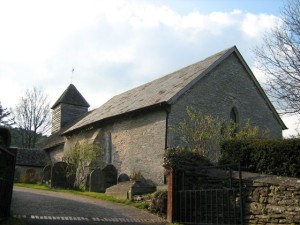The name, Bleddfa, is thought to derive from Blaiddfau, meaning ‘Place of the Wolves’. This dates from when the narrow valley was plagued by wolves. As late as Tudor times they could still be trapped and killed. There have been settlements in and around Bleddfa since the Iron Age, and possibly its parish church was built on a pre-Christian site.
The churchyard appears to be circular – which often suggests an ancient site – and the grassy mound at the west end of the church was thought to be a Bronze Age burial mound until the excavations of the early 1960s proved that it concealed the ruins of a tower. A further tradition has it that the church at Bleddfa was founded by the Irish Saint Brendan in the 6th Century, during the great age of Celtic saints which contributed so much to early Welsh lore and literature.
In 1066 Bleddfa belonged to the territory of Maelienydd, which was ruled by the descendants of Elystan Glodrydd, a powerful Welsh chieftain. However by 1093, most of Maelienydd was in the hands of the ambitious Norman barons, the Mortimers of Wigmore. By 1100 a castle had been erected at Bleddfa, as part of Norman defences against the still-turbulent Welsh, but no permanent church would be built for more than a hundred years. It is likely that the lords of Richard’s Castle were responsible for the building. The 14th Century octagonal font stands there, below the lovely 13th Century lancet window (shown in ‘Features Inside’).
By 1733 repairs had been made to floor, windows and roof.

At the beginning of the 20th Century Bleddfa Church underwent a major restoration. The image shows an old box pew panel. Buttressing was added to the north and south walls, and the interior was re-structured.


Ruined Mound:
Sadly, as the 20th Century progressed the population of the countryside began to decline, and the congregation dwindled. The excavation of the mound at the western end of the church in 1962-3 generated enormous interest. The images show the enormous width of the walls and the internal stairs down the wall to the lovely arched doorway inside the mound.




Was it built as a place of refuge? Instigated by the Radnorshire Society and supported by the Cambrian Archaeological Society, the work was directed by Mr L.A.S. Butler, of the Royal Commission on Ancient Monuments in Wales and Monmouthshire, in 1962 and Mr Frank Noble in 1963.
This historical information is taken from the booklet, The Church of St Mary Magdalene, written by Mary Oldham, copyright 2003, produced by C-4 Media Services. It is available in the church.